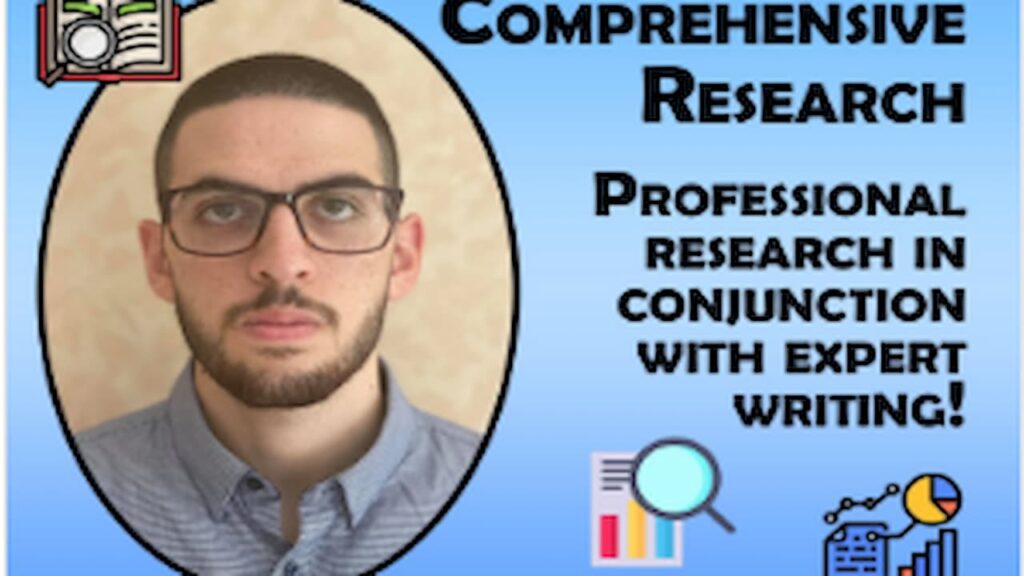In the ever-evolving landscape of knowledge and information, research and summaries play a pivotal role in distilling complex concepts and findings into accessible and comprehensible formats. Research involves the systematic investigation of a topic, guided by a sense of curiosity and a desire to uncover new insights or validate existing knowledge. On the other hand, summaries condense the essence of this research, presenting it concisely while retaining its essential meaning. Both research and summaries are indispensable tools that enable efficient communication, knowledge dissemination, and informed decision-making across various fields. This interplay between in-depth exploration and succinct representation forms the foundation of intellectual progress and effective communication in today’s information-driven society.
1 – Conduct comprehensive research and a thorough summary by Lambros S
I possess the capability to engage in research across a wide spectrum of subjects, tailored to your specific requirements. Upon conducting the research, I will furnish you with a document that encapsulates a summary of the findings, thoughtfully curated to align with your needs.
Rest assured, my summaries are designed to empower you with improved decision-making abilities and a clearer roadmap for your future goals. Drawing from my extensive experience in research, I am well-equipped to undertake this task, a competence that is evident from my published research paper on the topic of Artificial Intelligence and the Law. You can find the publication at this link:
Why Consider Choosing Me:
- A Reputable Source (Over 1,500 satisfied clients)
- Available Round-the-Clock (24/7)
- My Role as a Researcher in a Technology Law Firm
- Flexibility for Revisions
- Punctual and Timely Deliveries
2 – Write a perfect summary or synopsis of any document by Zaryab Z
I am adept at crafting impeccable summary documents for any content you provide. With my extensive background as a seasoned writer, I guarantee to deliver unparalleled quality in these summaries within the shortest timeframe possible.
3 – Do survey analysis visualization and report summaries by Syed U
As your dedicated Survey Consultant, I am prepared to convert your raw data into valuable, actionable insights.
Do you find yourself grappling with substantial volumes of survey data? Is the multitude of open-ended responses leaving you bewildered? Is deciphering and analyzing your discoveries proving to be a challenge?
Fret not, as I’m here to extend a helping hand!
Leveraging my robust foundation in accounting & Finance, an unwavering enthusiasm for data, and a mastery of data analysis tools, my expertise lies in:
- Survey Analysis: plungedge into your data, extracting pivotal insights and pinpointing noteworthy trends.
- Visualizing Responses: I transform intricate data into visually captivating graphs and charts for effortless comprehension.
- Crafting Reports: I succinctly encapsulate findings within compelling reports that facilitate decisive actions.
- Detecting Trends: I scrutinize your data to uncover prevailing patterns and avenues for enhancement.
- Driving Revenue: I unearth insights that have the potential to foster incremental revenue growth.
- Results-Centric Approach: My paramount objective revolves around empowering you to make well-informed choices and enact decisions grounded in robust, data-driven insights.
4 -Review your supplier sds and amazon feedback by
This opportunity is aimed at purchasers who don’t currently require SDS compilation but are seeking fundamental advisory services.
This entails evaluating the adherence of an already existing SDS, like one from a supplier or producer, or examining Amazon feedback related to an SDS that doesn’t meet criteria or has been turned down.
Furthermore, it encompasses addressing any questions or problems with Amazon concerning label content and its conformity.
5 – Do medical scientific research summary writing for you by Ana Luiza Dias
Are you in search of a researcher to craft scientific summaries for your company?
Relinquish the challenging aspects to me!
I am a seasoned researcher with 8 years of experience in the realm of life sciences.
My expertise lies in sleep and biotechnology, yet I possess the ability to delve into any subject within the life sciences domain.
Invest in a professional research adept.
With my assistance, you will receive:
- A concise overview of the most pertinent publications pertaining to the specified topic.
- Well-structured and clearly written material.
- Proper references and citations.
- Solutions to your scientific inquiries.
- Unique content devoid of plagiarism.
- Thorough research conducted solely in reputable scientific databases.
- Content verified through Grammarly.
FAQs
What is the best way to read scientific papers?
Reading scientific papers effectively requires a strategic approach to extract valuable information and understand the content. Here’s a step-by-step guide to help you navigate through scientific papers:
Skim the Abstract: Begin by reading the abstract, which provides a concise overview of the study’s objectives, methods, results, and conclusions. This will help you determine if the paper is relevant to your interests.
Examine the Introduction: Read the introduction section to understand the context, significance, and purpose of the study. This section often includes the research question or hypothesis, which gives you an idea of what the study aims to address.
Review Figures and Tables: Before diving into the main text, take a look at any figures, tables, graphs, or charts. These visual aids can help you grasp the key findings and trends without delving deeply into the text.
Read the Conclusion and Discussion: Jump to the conclusion and discussion sections to get an overview of the study’s outcomes and the researchers’ interpretations. This will give you a sense of the paper’s key takeaways.
Scan Methodology and Results: If the paper seems relevant, go back to the methodology and results sections. Focus on understanding the study design, experimental procedures, data collection methods, and the main results.
Look at Citations: Pay attention to the references cited in the paper. They can lead you to related studies and provide more context for the current research.
Read In-Depth: If the paper is still relevant and interesting to you, read it thoroughly. Take notes as you go, highlighting key points, methods, results, and any areas of confusion or disagreement.
Analyze and Critique: Engage critically with the paper. Assess the quality of the research, the validity of the methods, and the soundness of the conclusions. Consider the paper’s strengths and limitations.
Seek Clarification: If certain concepts or terminology are unclear, refer to textbooks, online resources, or even other scientific papers to clarify your understanding.
Take Breaks: Scientific papers can be dense and complex. Take breaks to avoid information overload, and return to the paper with fresh eyes to ensure comprehension.
Discuss with Others: Engage in discussions with colleagues, peers, or mentors about the paper. Explaining complex concepts to others can solidify your understanding.
Practice Regularly: The more you read scientific papers, the better you’ll become at extracting relevant information and understanding the nuances of research writing.
Remember that not every section of a paper needs to be read in detail. Your approach may vary depending on your purpose for reading the paper—whether it’s for a literature review, research project, or general knowledge gathering.
What is the importance of the summary of findings and conclusions in a research paper?
The summary of findings and conclusions in a research paper holds significant importance as it serves as the culmination of the entire study, encapsulating the results and insights generated from the research process. Here’s why this section is crucial:
Synthesis of Results: The summary of findings brings together the key outcomes of the study. It condenses the complex data and information into a concise format, making it easier for readers to grasp the main points without delving into the detailed methodology and results sections.
Answering Research Questions/Hypotheses: This section directly addresses the research questions or hypotheses posed at the beginning of the study. It provides readers with a clear response to the initial inquiries and demonstrates whether the study’s objectives were achieved.
Highlighting Contribution: The summary of findings highlights the unique contribution of the research to the existing body of knowledge. It showcases what new insights, information, or perspectives the study brings to the field, emphasizing its significance.
Supporting or Refuting Hypotheses: If the study was hypothesis-driven, this section showcases whether the hypotheses were supported or refuted by the collected data. This information is crucial for validating or revising existing theories.
Decision-Making and Practical Application: The conclusions drawn from the findings can have implications for decision-making in various contexts. It might guide future research directions, influence policy decisions, or offer practical recommendations for professionals in the field.
Validity and Reliability: Summarizing the findings and conclusions enables other researchers to assess the validity and reliability of the study. They can evaluate whether the data analysis methods were appropriate and whether the results align with the study’s scope.
Reader’s Understanding: Not all readers might have the time or expertise to analyze the entire paper. The summary of findings provides a snapshot of the study’s outcomes, making the research accessible to a broader audience.
Closure: It provides a sense of closure to the paper, wrapping up the research journey. Readers should be able to walk away from the paper with a clear understanding of what was discovered and what it means in the context of the research field.
Academic Communication: In scholarly communication, the summary of findings and conclusions is often the part that other researchers and scholars will initially read. It allows them to quickly determine if the study is relevant to their own work and interests.
Critical Reflection: The process of summarizing findings and drawing conclusions encourages researchers to critically reflect on their own work. It prompts them to evaluate the robustness of the evidence and the broader implications of their research.
In essence, the summary of findings and conclusions serves as the bridge between the data collected and the significance of the research. It’s the point where the study’s impact is showcased, making it a crucial component of any research paper.
Final thought
In the realm of academia, business, science, and beyond, research and summaries serve as dynamic partners in the journey of understanding and advancement. Through rigorous research, we unearth the depths of human knowledge, pushing boundaries and expanding horizons. Summaries then distill this wealth of information into manageable portions, allowing individuals to grasp the core ideas without getting lost in the intricacies. The symbiotic relationship between research and summaries underscores their significance in fostering both learning and progress. As we navigate an era characterized by an overwhelming influx of information, mastering the art of conducting meaningful research and crafting insightful summaries will continue to be invaluable skills, empowering us to navigate the vast sea of knowledge with clarity and purpose.



